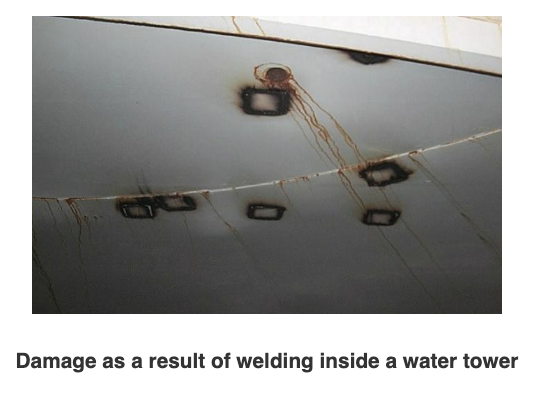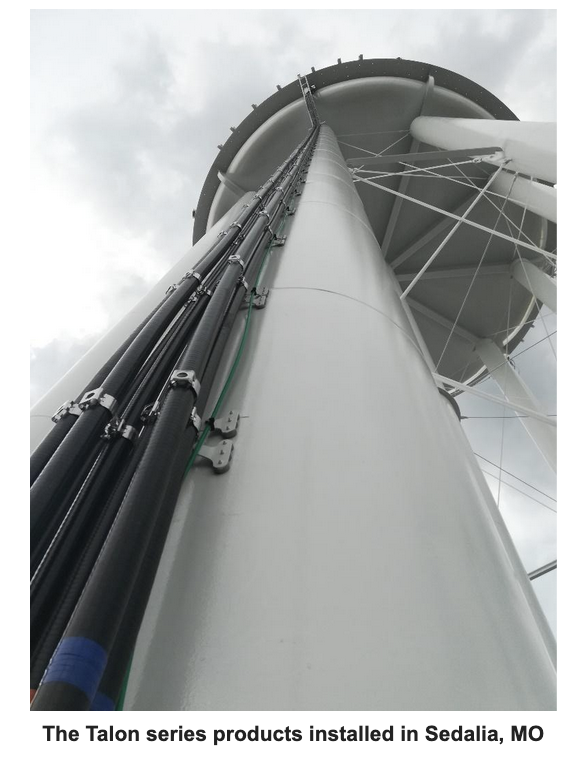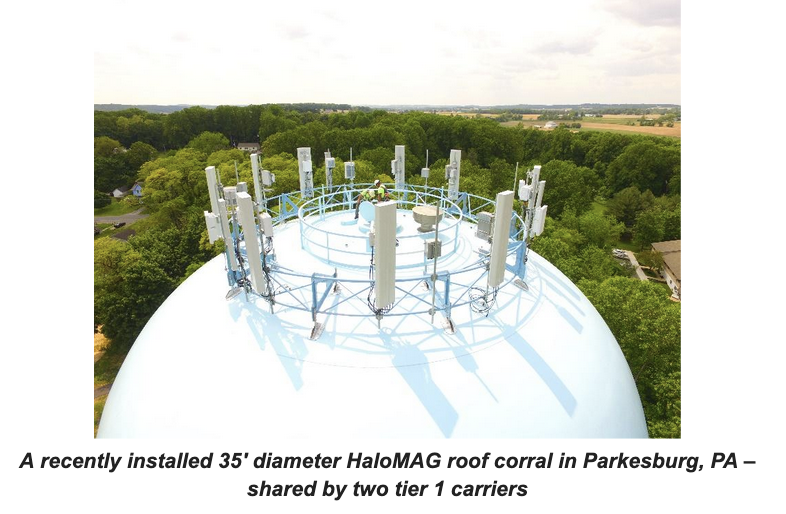
Established in 2012 by Stechmann, Estech Magnetics has a rich history in water tower and industrial coatings engineering, extending back 20 years. It has solved fastening challenges with a range of magnetic products, eight patents and a list of international project successes. Cables, conduit and antennas are now able to be installed with confidence and coolness using innovative rare-Earth magnetic designs, says Stechmann, who got started in the water industry when he was a civil and environmental engineering student at the University of Missouri Columbia.
After climbing nearly 1,000 water towers, he was tired of getting tangled up in loose cables and being scratched on the bolted antennas that were fastened directly to access ladders.
He discovered an “open-secret in the industry,” the popularity of an installation practice that violates a host of OSHA codes. For safety and structural reasons, regulations call for a minimum 7-inch clearance of any obstruction away from tower ladders, including the welded standoff bracket.
In 2010, one of Stechmann’s customers, who had been cited for cables being fastened to a water tower ladder, asked him for an alternative solution. Welding the brackets to a tower shell turned out to be too expensive, so he turned to magnets to create his first system to fasten cables to water tower structural steel.
The success of that first installation led him on a course to design larger brackets and allow for variable water tank curvatures. It was immediately evident that the benefits of the rare-Earth magnetic power would help alleviate poor installations and extend to other opportunities like monopole and small cell applications.
Ranging from the four magnet Talon1 to the “world record magnetic corral” HaloMAG, “tower owners and A/E firms alike are now insisting on magnetic applications,” says Stechmann.
The Differentiator
Estech uses neodymium rare earth magnets, instead of ceramic-style magnets, which are about 1.25 inches in diameter and have about 50 pounds of pull force vertically. “With the neodymium rare earth magnets, we’re able to get a tighter footprint and meet the tangency of water tower curved surfaces to make sure that the magnet is making full contact with the surface,” Kaylee Stechmann, Vice President at Estech, told Inside Towers.
Every batch of magnet and bracket design goes through a rigorous testing program to record observed shear and vertical forces. Aspects that affect the reaction force of a magnet include: steel thickness, coating thickness, temperature and coefficient of friction. Estech understands these variables and is able to use real-world testing with 3D modeling to meet or exceed TIA specifications on applicable products.
“With an expected 30-year life span we classify our products as a permanent fastening solution, comparable to a welded solution,” Kaylee says.
One of the first design quandaries that Eric faced was the need to meet the curvature of steel on tower legs, sidewalls and roofs. If a bracket does not accommodate for these convex and concave arcs, the magnets will not sit level to the steel and will not realize their magnetic potential. With this in mind, Eric applied for his first patent in 2013, which describes the ability to meet curved steel tangency by permanently hydraulic pressing each bracket custom-tuned to a reported diameter. This is the Talon Bracket.
However, the industry was in great need for a magnetic bracket that did not require any measuring or reporting, says Eric. Crews were so busy during the summer of 2020 he was told that visiting a tower site for diameter measurement was not feasible. So, he got to work again and designed the “head-turning and metal-twisting” TalonFLEX system.
The FLEX design allows magnetic brackets to be “stockable” and “grab-and-go” with the exterior magnetic pads pivoting on axis to conform to any curve, convex or concave, that an installer could happen upon. The FLEX design is cut out of a single piece of stainless steel with a ½ million-dollar CNC laser reducing PIM interference by eliminating additional parts needed to create a traditional hinging system.
“The FLEX technology now makes our products entirely flexible. Out of the box, they automatically form to and conform to any diameter on a water tower,” Kaylee says.
“We really pride ourselves on listening to our customers,” Kaylee says. “We’ve always been very hands-on with installations, working in the field with crews or doing installations ourselves to ensure efficient product designs for the industry.”
Estech focuses on a full range of magnetic systems that covers the fastening of every aspect of a water tower colocation project. To attach antennas to the tower, Estech features the Sidewall Antenna Bracket, TripodMAX and the HaloMAG™ Magnetic Roof Corral System. Bracket size and magnet quantity increase proportionality to ensure that they are in compliance with the loading parameters. Larger brackets are reviewed by a third-party engineering firm and PE stamped to verify compliance with TIA 222, Rev. H.
Released in 2022, the HaloMAG™ system is a fully engineered magnetic structure that is used as a communications real estate fastening system for water tower roofs. The magnetic bracketing system currently ranges from 15 feet wide to 35 feet wide and features approximately 1,500 to 2,000 high-strength rare-earth magnets each. That’s a combined ideal vertical pulling force over 100,000 pounds.
“The entire water tower structure gets a structural analysis to ensure that it can accommodate the full build-out under environmental loading,” Kaylee says. “And the entire HaloMAG™ structure with the magnetic feet gets a mount analysis by a third-party engineering firm to ensure that we have the correct magnetic loading, and that all of our structural components are in compliance.” The 35-foot wide version has been reviewed to hold several carriers,” Kaylee says.
You may be wondering how such powerful magnetic systems are placed, positioned and removed with control. The answer is the Hoverbolt™ system, a series of threaded bolts with softened tips that are able to keep the magnets off the tower with only 1% power until the bolts are unthreaded, allowing the magnetic pads to come into full contact with the steel surface. Reversing the procedure will allow the bracket to dismount with command and control.
The future looks bright for Estech, says the Stechmanns. It will be building a new facility later this year, and it will be adding more personnel. The addition of a fiber optic laser will allow it to laser cut its parts and perform all its fabrication in-house.
“Our company was really born out of the need to protect water tower structures and, by extension, our water supply,” Kaylee says. “Then it turned into a fantastic solution for the telecom industry, because we’re saving time on labor and eliminating the need for expensive welding and burn repairs.”
For more information, visit https://estechmagnetics.com/ or email [email protected].






Reader Interactions